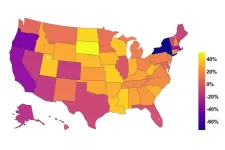(Press-News.org) Scientists testing a new method of sequencing single cells have unexpectedly changed our understanding of the rules of genetics.
The genome of a protist has revealed a seemingly unique divergence in the DNA code signalling the end of a gene, suggesting the need for further research to better understand this group of diverse organisms.
Dr Jamie McGowan, a postdoctoral scientist at the Earlham Institute, analysed the genome sequence of a microscopic organism - a protist – isolated from a freshwater pond at Oxford University Parks.
The work was intended to test a DNA sequencing pipeline to work with very small amounts of DNA, such as DNA from a single cell. Dr McGowan was working with a team of scientists at the Earlham Institute and with Professor Thomas Richards’ group at the University of Oxford.
But, when researchers looked at the genetic code, the protist Oligohymenophorea sp. PL0344 turned out to be a novel species with an unlikely change in how its DNA is translated into proteins.
Dr McGowan said: “It’s sheer luck we chose this protist to test our sequencing pipeline, and it just shows what’s out there, highlighting just how little we know about the genetics of protists.”
It is hard to make any statements about protists as a group. Most are microscopic, single-celled organisms like amoebas, algae, and diatoms, but larger multicellular protists exist – such as kelp, slime moulds, and red algae.
“The definition of a protist is loose - essentially it is any eukaryotic organism which is not an animal, plant, or fungus,” said Dr McGowan. “This is obviously very general, and that’s because protists are an extremely variable group.
“Some are more closely related to animals, some more closely related to plants. There are hunters and prey, parasites and hosts, swimmers and sitters, and there are those with varied diets while others photosynthesise. Basically, we can make very few generalisations.”
Oligohymenophorea sp. PL0344 is a ciliate. These swimming protists can be seen with a microscope and are found almost anywhere there is water.
Ciliates are hotspots for genetic code changes, including reassignment of one or more stop codons - the codons TAA, TAG, and TGA. In virtually all organisms, these three stop codons are used to signal the end of a gene.
Variations in the genetic code are extremely rare. Among the few variants of the genetic code reported to date, the codons TAA and TAG virtually always have the same translation, suggesting that their evolution is coupled.
“In almost every other case we know of, TAA and TAG change in tandem,” explained Dr McGowan. “When they aren’t stop codons, they each specify the same amino acid.”
DNA is like a blueprint of a building. It does not do anything in and of itself – it provides instructions for work to be done. In order for a gene to have an impact, the blueprint must be “read” and then built into a molecule which has a physical effect.
For DNA to be read, it is first transcribed into an RNA copy. This copy is taken to another area of the cell where it is translated into amino acids, which are combined to make a three-dimensional molecule. The translation process starts at the DNA start codon (ATG) and finishes at a stop codon (normally TAA, TAG, or TGA).
In Oligohymenophorea sp. PL0344, only TGA functions as a stop codon - although Dr McGowan found there are more TGA codons than expected in the ciliate’s DNA, believed to compensate for the loss of the other two. Instead, TAA specifies lysine and TAG specifies glutamic acid.
“This is extremely unusual,” Dr McGowan said. “We’re not aware of any other case where these stop codons are linked to two different amino acids. It breaks some of the rules we thought we knew about gene translation – these two codons were thought to be coupled.
“Scientists attempt to engineer new genetic codes - but they are also out there in nature. There are fascinating things we can find, if we look for them.
“Or, in this case, when we are not looking for them.”
This research, published in PLoS Genetics, was funded by the Wellcome Trust as part of the Darwin Tree of Life Project, and supported by the Earlham Institute’s core funding from the Biotechnology and Biological Sciences Research Council (BBSRC), part of UKRI.
ENDS
About the Earlham Institute
The Earlham Institute is a hub of life science research, training, and innovation focused on understanding the natural world through the lens of genomics.
Embracing the full breadth of life on Earth, our scientists specialise in developing and testing the latest tools and approaches needed to decode living systems and make predictions about biology.
The Earlham Institute is based within the Norwich Research Park and is one of eight institutes that receive strategic funding from the Biotechnology and Biological Sciences Research Council (BBSRC), part of UKRI, as well as support from other research funders.
earlham.ac.uk
END
The end of genes: routine test reveals unique divergence in genetic code
2023-10-05
ELSE PRESS RELEASES FROM THIS DATE:
Conscience launches to tackle drug discovery and development for diseases sidelined by pharmaceutical science
2023-10-05
TORONTO (5 October 2023) – Conscience, a game-changing non-profit venture focused on enabling drug discoveries for diseases that have received limited attention from the pharmaceutical industry, launched today with pioneering support from the Canadian government.
With CA$105.7 million in funding, including $49 million from the Canadian government and the engagement of industry, academia, government and patient advocacy groups, Conscience seeks to lead global drug discovery and development for emerging, rare or complex ...
Isis presents a special bibliographic issue on the history of pandemics
2023-10-05
In 1913, historian of science George Sarton created what has become the Isis Current Bibliography of the History of Science (IsisCB). For the last 110 years, the journal Isis has included a comprehensive survey of the recent work in the history of science and allied fields, first in each issue and later as a full yearly supplement. Now the basis of a free online search tool called IsisCB Explore, the IsisCB continues to serve as an indispensable reference for scholars and students.
“Bibliographic ...
Plot thickens in hunt for ninth planet
2023-10-05
CLEVELAND—A pair of theoretical physicists are reporting that the same observations inspiring the hunt for a ninth planet might instead be evidence within the solar system of a modified law of gravity originally developed to understand the rotation of galaxies.
Researchers Harsh Mathur, a professor of physics at Case Western Reserve University, and Katherine Brown, an associate professor of physics at Hamilton College, made the assertion after studying the effect the Milky Way galaxy would have on objects in the outer solar system—if the laws of gravity were governed by a theory known as Modified ...
Factors associated with marijuana use among high-risk college students
2023-10-05
The past decade has seen a significant increase in marijuana use among U.S. college students. This increase has coincided with notable changes in national and local cannabis laws and policies, and perceptions of the associated drug’s risk over the same period. However, cannabis use by students continues to be a public health challenge throughout the country. Universities have long relied on education programs to address these risks; however, many of these programs have limitations and fail to consider some of the modern risk factors ...
Precise gene editing in human stem cells and neurons reveals links between genome organization and autism
2023-10-05
NEW YORK, NY (October 5, 2023) – Researchers have used CRISPR gene editing, stem cells and human neurons to study the impact of a gene that is commonly mutated in autism. This new study, published today in The American Journal of Human Genetics, ties mutations in the gene CHD8 with a broad spectrum of molecular and cellular defects in human cortical neurons.
Autism is a highly heritable disorder with a recent increase in incidence — approximately 1 in 40 children in the US are diagnosed with autism. Over the past decade, sequencing studies have found many ...
AI helps reduce online harassment by enhancing conversation courtesy
2023-10-05
Check the comments section of many social media and digital news platforms, and you’re likely to find a cesspool of insults, threats and even harassment. In fact, a Pew Research Center survey found that 41% of American adults have personally experienced online harassment, and one in five adults say they’ve been harassed online for their political views.
But researchers at BYU and Duke University say derisive online conversations don’t have to be the norm. A joint paper between the two universities found that artificial intelligence can be used to improve conversation quality and promote civil dialogue in online ...
Two-day course teaches hospitals and health systems how to address unprofessionalism and unsafe behavior
2023-10-05
With a myriad of external pressures and challenges facing hospitals and health systems today, it is more important now than ever to mitigate internal risks. Unprofessional behavior, which negatively impacts patient care, retention, and team dynamics, is a legal, financial, and cultural risk that many health systems are now looking to address head-on. Peer-reviewed research consistently shows unprofessional behavior in health systems can be reduced by 85% through implementing the right tools and processes.
The Vanderbilt ...
Study highlights use of TikTok to encourage cervical cancer screening
2023-10-05
TikTok and other short-form video platforms are booming in popularity — for entertainment and for sharing information, including health information.
Researchers are currently examining the effects of social media videos, and among them is Ciera Kirkpatrick, assistant professor of advertising and public relations at the University of Nebraska–Lincoln. Kirkpatrick, who studies the intersection of communication and health, recently turned her scientific eye toward TikTok.
In a newly published article, Kirkpatrick and co-author LaRissa Lawrie, a doctoral ...
K-pop fans helped COVID-19 public health messaging go viral
2023-10-05
Three years ago, as part of the public health messaging in response to the COVID-19 pandemic, the World Health Organization launched the "Wear A Mask" campaign on social media.
However, despite their benefits to public health, mask-wearing quickly became a highly politicized and divisive issue across the globe.
But the campaign gained impressive traction after World Health Organization Director-General Tedros Adhanom Ghebreyesus issued the following tweet on X, the social media platform known at the time as Twitter, on August 21, 2020, thanking BTS, a South Korean K-pop group, for supporting the mask-wearing public ...
Physicists find evidence for magnetically bound excitons
2023-10-05
In art, the negative space in a painting can be just as important as the painting itself. Something similar is true in insulating materials, where the empty spaces left behind by missing electrons play a crucial role in determining the material's properties. When a negatively charged electron is excited by light, it leaves behind a positive hole. Because the hole and the electron are oppositely charged, they are attracted to each other and form a bond. The resulting pair, which is short lived, is known as an exciton [pronounced exit-tawn].
Excitons are a key part of many technologies, including solar panels, photodetectors and sensors, as well as light-emitting ...




